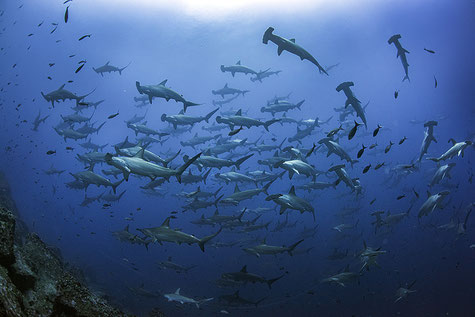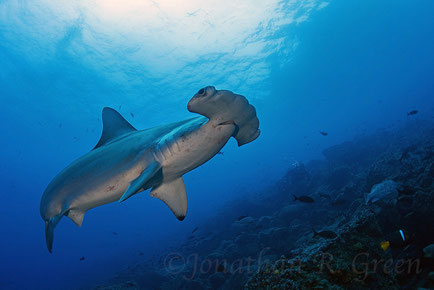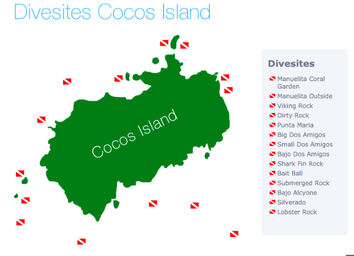Cocos Dive Adventure
A different dive adventure - Dive with the whale shark experts! Enjoy the silence & adventure of Cocos' unique underwater world while supporting research & conservation of whale sharks!
Get tips in a photo workshop on board on how to get THE shot!
Here you get information about ...
Why dive Cocos Island?

Among Cocos Island’s many attribute is a startling degree of biodiversity. This Island’s world-renowned waters explode with life, including innumerable white tip reef sharks, schooling hammerhead sharks, tiger sharks, dolphins, mantas and marbled rays, giant moray eels, sailfish, and of course the occasional whale shark. Other common encounters are large schools of jacks and tuna, silky sharks, silvertip sharks, marlin, Creole fish, green sea turtles, and octopus.
Cocos - a paradise for big animal diving where you can see an incredible high amount of different shark species: tiger sharks, hammerhead sharks, Galapagos sharks, whale sharks, silky sharks, silvertip sharks, white tip reef sharks and black-tip sharks! Which get joined in by giant manta rays, different rays and dolphins!
Beneath the waterfalls and in the rivers, are freshwater fish that mystify scientists by their very existence. Because of its remote location and abundance of freshwater, Cocos has, throughout history, been a favourite re-supply station for pirates, whalers and sailors.
Why dive with us

- Photography Workshop and practical advice about photography on land and underwater directly onboard by Jonathan R. Green!
- Citizen Science instruction ~ Learn how to provide data to support actively local & worldwide research. You can get engaged with shark conservation now & make a difference wherever in the world you go diving!
- Presentations on board related to research of the Galapagos Whale Shark Project & Citizen Science!
- Small group - Maximum of 18 passengers
- Dive with the Shark Expert Jonathan R. Green and tour leader Jenny Waack and get details about the research project in Galapagos and 'behind-the-scene-stories' of filming 'BBC Blue Planet II' directly from the project leader Jonathan.
- Travel always responsible! On our Eco Dive Tour we will pay attention how to travel economically responsible and behave respectful to wildlife.
- 6 dive masters - 1 dive master per 3 divers!
- We offer translation onboard in English, German, Spanish and French.
Why Galapagos Shark Diving?
Galapagos Shark Diving® offers dive trips to the world's most beautiful destinations and combines it with supporting marine conservation. The knowledge about sharks and training teaches how every diver can support conservation of endangered marine wildlife – with no science background needed. Every year only a few Shark Conservation Dive departures are offered in the best shark diving season and best months to dive in the islands of Galapagos and Cocos (July – October). Every dive trip is accompanied by shark scientists from the Galapagos Whale Shark Project, which is featured in the BBC Blue Planet II series.
For every diver the organization donates to the research of the Galapagos Whale Shark Project. This team is studying the unique population of adult whale sharks in the Galapagos. Find more information about the research project.
Each scientist will provide you with extensive knowledge about whale sharks and will teach you at the same time how you as a diver can support conservation of marine wildlife such as whale sharks, giant manta rays, sea turtles, other shark species, rays, molas, whales and other endangered animals – and that worldwide. You too can make a difference! Find out more about the programs on board
"In the end we will conserve only what we love; we will love only what we understand; and we will understand only what we are taught." (Baba Dioum)
This quote is very true as governments who decide about protection zones will only protect what they understand.
Every year millions of sharks are killed for their fins or caught as “bycatch” like many other marine wildlife like manta rays, turtles, sea lions amongst others. One way to ensure that a species may survive is to protect those areas key for their reproduction (mating, birthing, etc.). Until now only 5 % of the world oceans are truly protected! Furthermore, we don’t yet know precisely the areas where for example, whale sharks give birth or mate! In order to ensure that these gentle giants will not go extinct we need to identify such areas and create marine reserves and sanctuaries, in order to halt the population declining further. The Galapagos Islands could be one of the key locations where adult female whale sharks give birth and is already recognized as a vital nursery for other shark species in the Eastern Tropical Pacific Region. On our Shark Conservation Dive Trips we collect data which furthers our understanding of whale sharks and other marine wildlife and that helps us to promote Conservation through education and awareness.
If you would like to know what other divers say about travelling with us, check our review page where you can find travel reviews and experiences of our guest.
The Itinerary

Many kinds of dives on offer, ranging from vertical walls, drifts, pinnacles, as well as incredible marine life, including hammerhead sharks, tiger sharks, sailfish and whale sharks.
Spent diving the pinnacles around the perimeter of Cocos Island. Divers usually average three dives per day at depths of 60-100ft (18-30m) or more. This, of course, is what the whole trip is about.
The dive adventure starts and ends in San Jose (ship will leave from Puntarenas). We will stay 11 days/10 nights on the ship and explore the magical world of Cocos Island.
The Sea Hunter also includes a variety of land trips to explore the stunning of Costa Rican Forest. With a unique speedboat ride you will explore the beautiful scenery.
Also you can decide to take your adventure to a higher level and go on a deep submersible dive to 300m/1000 ft.
The Ship

The ship is a purpose built 35m dive live aboard which was originally a commercial dive-support vessel serving the oil industry in the Gulf of Mexico. Because of this she is a superbly stable and robust vessel and also has ‘zero speed stabilisers’ which are lowered into the water when she is moored to give added stability, making the ship an ideal choice to take you on an amazing adventure diving the Cocos Islands of Costa Rica.
Her renovations turned her into a very comfortable dive live aboard, with underwater photographers in mind and all the facilities needed. The M/V Sea Hunter has 10 air-conditioned cabins with en-suite bathrooms for added comfort. She also has a study and lounge area, perfect for relaxing, editing photos or watching a DVD.
The ship's chef will provide varied, abundant and nutritionally balanced meals with a combination of American and Costa Rican cuisine.
The Price
In 2022
USD 6,325 per person
EUR 5.470* per person
| USD 6,325** per person based on double occupancy for 11 days / 10 nights |
| + USD 0 per person photography workshop with Jonathan R. Green |
| + USD 0 per person talks/lectures about Citizen Science, sharks & whale shark research project |
| + USD 0 per person 2 additional dive master (ratio: 1 dive master per group of 3 divers) |
| + USD 0 per person Citizen Science Instruction - 'How can YOU support conservation?' |
| Total USD 6,325 per person. |
* based on the exchange rate from 30 October 2021
** Please note, on the upper deck suites the price is USD 6,775. Only 2 cabins available.
Available date
In 2022:
29 September - 09 October 2022


















